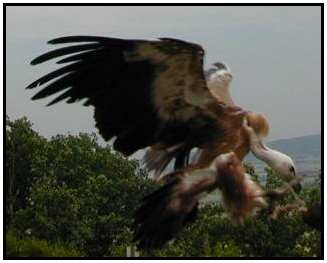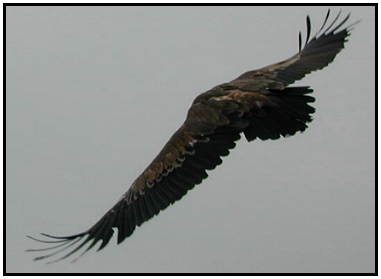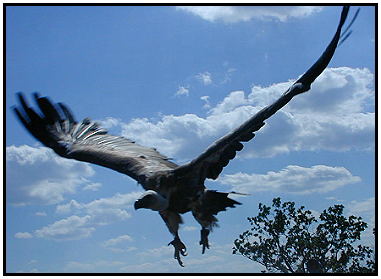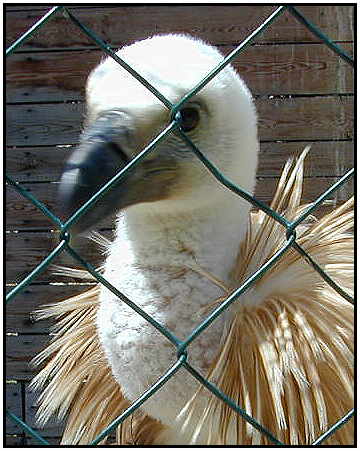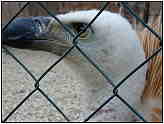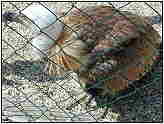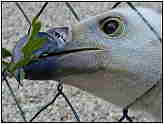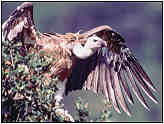Eurasian GriffonOrder: Falconiformes. Family: Accipitridae. (Old World vulture). Scientific Name: Gyps fulvus. Common Names: Eurasian Griffon or Griffon Vulture. Conservation Status: Threatened. Reduction in numbers due primarily to a lack of food. Still reasonably abundant in Spain; virtually extinct in Sicily. Balkan numbers have also diminished greatly.
Eurasian Vulture (Photograph Courtesy of Erich Mangl (Copyright ©2000)Rescue & Recovery: In Spain and Sardinia the World Wildlife Fund has feeding stations for these birds and they are kept constantly stocked with carrion. Objectors say this technique may cause the birds to become semi-tame and lose the ability to find food for themselves. Supporters point out that it may be a more hygienic way of disposing of carcasses than burial. By feeding the corpses to the vulture harmful bacteria, which would once have entered the water supply, is destroyed by the vulture digestive juices. Geographical Range: Asia, northwestern Africa, India and Turkey. Very small numbers in the Balkans, Sardinia, Cyprus, Crete, and Sicily. Even in very cold areas, Eurasian Griffons are resident throughout the entire year and have a special metabolism which enables them to conserve the needed energy to survive the worst winters. Habitat: Rocky coasts, or mountainous regions with open areas.
Eurasian Vulture (Photograph Courtesy of Erich Mangl (Copyright ©2000)Physical Characteristics: The Eurasian Griffon is about 100 centimetres long and has body plumage which is predominantly brown. Wings and tail are black while the neck and head are of a white down. The base of the neck has a collar of creamy white feathers and the bird is able to withdraw its entire two-foot long neck and head into this ruff. Immature birds can be easily distinguished as this collar remains brown until maturity. The Eurasian Griffon croaks, growls and whistles, but will do so only at feasts and in family groups. Flight is always done in complete silence. Food: Carrion. Despite its large size, this bird seldom kills its food and usually will not touch prey showing any signs of life. The interesting question is how does the vulture know an animal is dead and not simply resting? The answer to this is not known, however it is possible the birds simply 'mark' any animal which is lying separate from the main flock. The next day the animal is still there so the vulture circles lower and sees no sign of movement. Our vulture continues to circle and watch, the next day dropping low enough to look for the slightest eye movement or signs of breathing. Finding none the vulture lands a short distance away and stands erect with its neck stretched out, peering intently at the dead animal. By this stage a large group of vultures will be circling overhead, ready to join in the feast. Our lone vulture hops forward, takes a peck at the carcass and leaps back, always ready to take flight if the animal moves. When it does not the vulture throws himself on the body. This process is thought to take a minimum of two days, often longer.
Eurasian Vulture (Photograph Courtesy of Erich Mangl (Copyright ©2000)The Eurasian Griffon is frequently seen around the burning ghats of India where it waits patiently for any corpses not consumed by fire to fall into the river. The fact that Hindus regard the cow as a sacred animal means they never kill it and there are always plenty of cattle which die of age or disease to attract this bird. As a result India has one of the worlds most healthy populations of vultures. This is another vulture with a weak beak meaning it is unable to break through the tough hide of a dead animal and must wait for other species to tear open the carcass, or for the sun and time to soften the skin. At each meal the birds will gorge themselves on up to 5.4 kilograms of carrion. Once satisfied and have the crop, throat and neck are distended, they relax back on their tails, wings spread to provide balance and mouth hanging open. It will be about an hour before the meal is digested enough for the birds to take flight once more and the takeoff is very labour-intensive involving much running and leaping across the plains.
Eurasian Vulture (Photograph Courtesy of Erich Mangl (Copyright ©2000)Reproduction: Nests in the hollows of rocks, on cliff ledges or in caves, usually in colonies. The single egg is white with red spots and takes between 48-54 days to hatch. The female Eurasian Griffon will rarely leave the nest from he time of laying the egg until her young has taken flight. Consequently, the male vulture must provide food for all of them. He settles on a nearby ledge and regurgitates food, sorting out the contents with his beak. The female takes the larger pieces for herself and feeds the smaller pieces to the whistling chick. The young develop plumage at around 70 days and first fly at 110-115 days. Thumbnails (Click For Full-Size Image):
|

